There’s no argument – the Porsche 911 Carrera 3.0 RSR is a true classic…
This new model leapt off the pages of the 2021 Scalextric catalogue – an iconic car, two stunning liveries and plenty more to come. These will be great to collect and – as we’ll find out – superb on the race track too. Not expected until a little later in the year, Scalextric very kindly sent me a pre-production sample to have a look at and to take for a spin…
The two models scheduled for this year are the Jägermeister-sponsored Kremer Racing car, available to pre-order here: https://www.jadlamracingmodels.com/scalextric-slot-car-c4211-porsche-911-rsr-3-0-jagermeister-kremer-racing/ – and Al Holbert’s 1974 Trans-Am entry, available here: https://www.jadlamracingmodels.com/scalextric-slot-car-c4241-porsche-911-rsr-3-0-trans-am-1974-al-holbert/
The Real Porsche 911 Carrera RSR 3.0
The Porsche 911 Carrera RSR 3.0 was raced everywhere in the 1970s and early 80s – all the big endurance races, numerous GT and touring car series, American Trans-Am and rallies too. It is still a fixture in historic circuit racing and rallying. Fifty-four RSR (RS Racing) versions were produced by Porsche for the 1974 and 1975 seasons. Changes in racing regulations meant the end of the mighty 917, so Porsche looked to produce a GT car that could dominate across the board. Based on the iconic Porsche 911 Carrera RS road car, a lightweight 2.7-litre race car with widened rear arches and the characteristic ‘Burzel’ spoiler debuted in 1973. Success on the track and in the showroom led Porsche to develop fifty-five 2.8 RSR race cars with wider rear wheels, the big front air dam, disc brakes borrowed from the 917 and a highly-tuned 2.8-litre engine.
The next evolution was the 3.0 RS road car. Similar to the 2.8 RSR on the outside, this was a ‘homologation special’ with 100 cars produced to qualify for Group 3 in the FIA Production GT class. Fifty-four of these cars were taken and worked up as the ultimate 1970s GT racing car – the Porsche 911 Carrera 3.0 RSR. The motor was refined to produce a massive 330bhp at 8,000rpm – 100 more than the ‘standard’ 3.0 RS. On the outside, huge 14-inch rear wheels required even bigger arches and the rear wing went from being a ‘duck-tail’ to nearer the ‘whale-tail’ of later Porsche GT cars. The combination of massive power, low centre of gravity and fabulous mechanical grip made the 3.0 RSR an incredible car to drive.
The Jägermeister-sponsored Kremer Racing car took part in the 1975 Monza 1000kms. Driven by Helmut Kelleners and Hans Heyer, the #76 Porsche qualified well in the GT3.0 class, but retired from the race with engine failure. The car was repainted in its more familiar green Vaillant colours for the rest of the 1975 season, finishing ninth in the Le Mans 24 hours – Porsche 911 Carreras dominating the GTS and GT classes at that year’s race.
The Scalextric Model
My first impressions were “wow!” – the bright orange livery really jolts the senses and looks completely awesome. The big chin, huge rear wheel arches and the ‘whale-tail’ spoiler make this Porsche most definitely a 3.0 RSR. I’ve studied lots of photographs and watched some video of the real cars in action and I reckon the Scalextric design team have captured the shape and the lines almost perfectly. Possibly because I’ve seen plenty of not-so-accurate models and replicas, I did expect the rear to be raked-up a bit more (see side-on pictures below), but pictures of real 3.0 RSRs suggest the Scalextric car is spot-on. There is a bit too much air between the top of the front tyres and the arches – and that adds to the impression the front is too high. However, the horizontal line from the headlights to the spoiler is correct – a very slight slope from front to back. If I was going to be ultra-picky, I think the rim of the rear wheel arches is slightly too flattened. It shouldn’t be perfectly round – and the wheels do sit slightly forward of centre on the real RSR – but it is a little overdone to my eye.
In terms of detailing, I was mostly very happy – and who wouldn’t be with that vivid Jägermeister colour scheme. Of course, the car is a compromise between a highly-detailed scale model and one that’s robust enough to provide hours of enjoyment on a slot car track… That means the air intakes around the rear wheel arch are simply moulded recesses – the one to the front of the arch would have looked better painted. Also, the vent that should be between the front quarter panel and door isn’t there – it’s just a right-angle cut-off, which doesn’t look great. An actual vent would make the car much more fragile, but there could have been a slight recess. One final vent issue is the characteristic 911 engine cover – I would have liked a more pronounced grille, nice and tactile when I run my finger over it. And could the BBS spoked wheels have been a more detailed moulding, like on the Scalextric Sierras? Probably, but they still look good. This is a pre-production sample, so there may be a few improvements before the Porsche finally hits the assembly line.
The Mechanical Stuff
Underneath, there’s a classy Porsche crest over the motor. I do like those cut-outs! The second thing I noticed were those massive rear tyres… each one is 13.5mm wide. The front wheels are much thinner, but are nicely spaced to fill the wheel wells. On the set-up plate, the front tyres rotate freely – although re-profiling the braids drops them down so they just touch the surface. This set-up is perfect for good front-end stability and makes me very happy indeed. That’s mechanical grip sorted, but what about the magnets? On my DIY magnet gauge, the Porsche measures 45g – which is on the higher end of the scale for recent Scalextric releases. The underpan is Digital Plug Ready (DPR), meaning it can be easily converted to Scalextric digital using the C8515 Digital Plug or to Carrera Digital132 using the Carson digital conversion chip.
Removing the three screws (two front, one at the back) releases the body from the underpan. I was surprised that the front valance – the ‘chin’ – stayed on the underpan. However, when I thought about it, the Trans-Am car has a different moulding at the front, so it makes sense for manufacturing purposes. What this means is that loosening the screws at the front doesn’t do anything apart from ruin the beautiful profile – no good for creating body float – although loosening the rear screw is effective. The good news for racers is that the valance could be removed from the underpan and attached to the main body moulding – that should be ideal for tuning. Looking closely, I also noticed the body posts on the underpan don’t have a lip round the edge. This means the body isn’t held firm, which is great for creating body float.
Beyond that front moulding, the inside of the car is pretty standard for a modern Scalextric car – tray interior, easy-fit guide, inline short can motor, fabulous front and rear lights, plus the magnet just behind the motor. Scalextric researcher Simon told me that they’d looked at fitting the motor as a sidewinder, but it just wouldn’t fit between those big rear wheels. To be honest, I’m really glad they kept the authentic mega-wide wheels and went with the inline motor. I reckon it’s about time to give the Porsche a test drive on my Jadlam SL6 Test Track…
Track Performance
Oh my giddy aunt! This car is simply sensational. I know I’m prone to some occasional hyperbole, but the orange Porsche really is rather special on the track. As I’d expected, the car was pretty planted with the magnet and the big tyres. That could have been a bit boring – plus a recipe for disaster when adhesion was lost. I experimented by pushing the car really hard round the corner onto the main straight… and got a wonderful power slide. When the magnetic traction went, those big rear tyres gripped enough for me to control the slide with plenty of throttle. No surprise that I got totally carried away and was power sliding in every corner I could… brilliant fun. And never a hint of the car tipping.
Big slides are not the quickest way round a circuit, so I had to rein myself in and focus on a two-minute run with the ARC app. The Porsche was quick and nimble round the radius 2 turns and accelerated instantly down the straight. I was really enjoying running against the clock, but couldn’t resist a couple of power slides. At the end of the two minutes, I was very pleased with the 28 laps, but the fast time of 4:09 seconds was quicker than I’d anticipated. That puts the Porsche between the BMW 330i and the Aston Martin Vantage GT3 on the SL6 Leaderboard – and easily the fastest out-of-the-box performance.
For me, slot cars don’t stay in a box on a shelf, they get raced hard. Although I had a couple of very minor grumbles about the detail on this model, the driving experience more than made up for that. Without any doubt, the Porsche 911 3.0 RSR is my new favourite Scalextric car.
Scalextric Porsche 911 3.0 RSR ‘Jägermeister Kremer Racing’ Data Sheet
Catalogue code: C4211
Available here: https://www.jadlamracingmodels.com/scalextric-slot-car-c4211-porsche-911-rsr-3-0-jagermeister-kremer-racing/
Range: Scalextric Classic GT Cars – 1/32 scale / high detail / Digital Plug Ready (DPR)
Scheduled: Summer/ Autumn 2021
Spares included: 2 x braid plates with braid fitted
Lights: front and rear
Motor: Scalextric ‘short-can’ – inline orientation.
Gear ratio: 9:27
Length: 137mm
Wheelbase: 70mm
Rear axle width: 58mm
Height: 40mm
Weight: 75g (body = 23.5g not including front valance)
Andy’s downforce gauge: 45g magnetic downforce


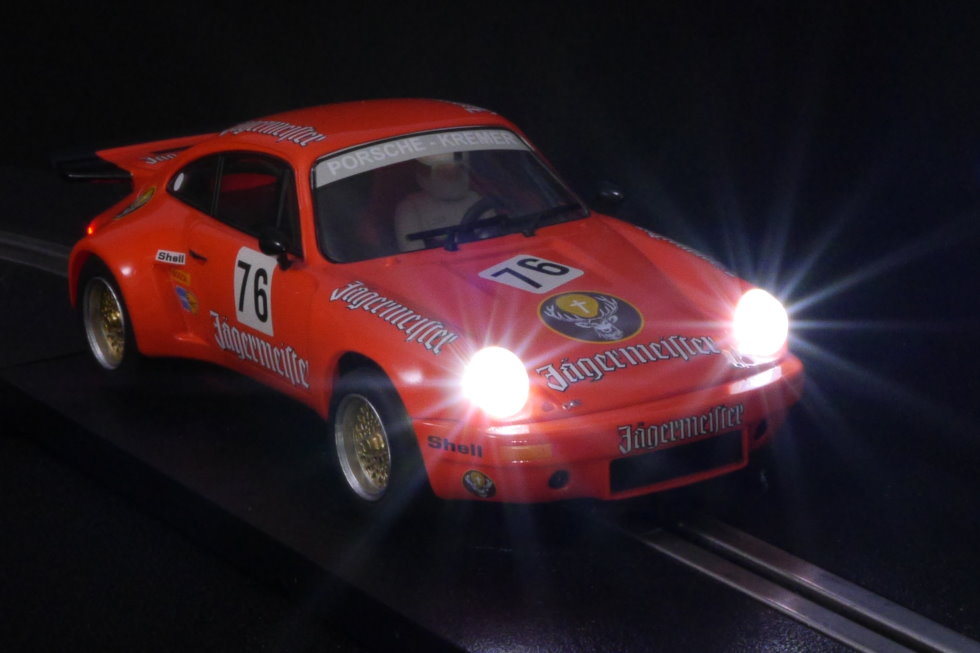
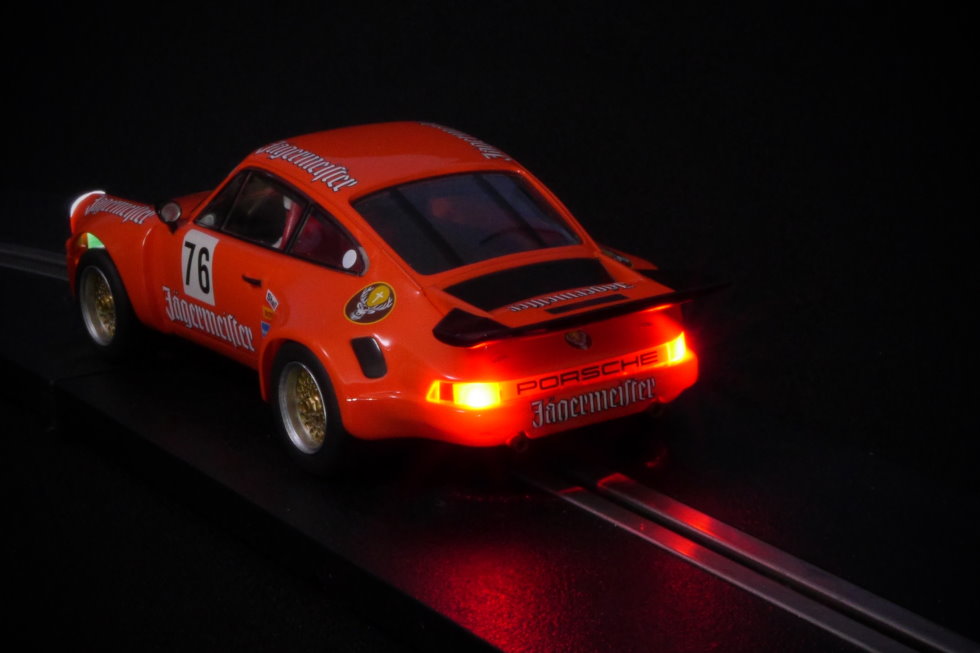
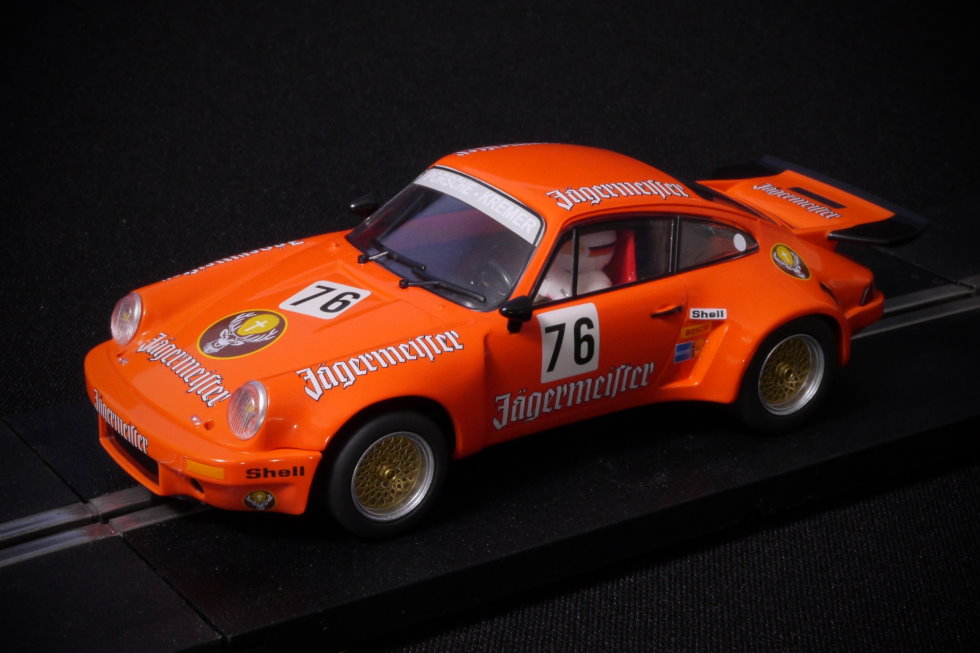
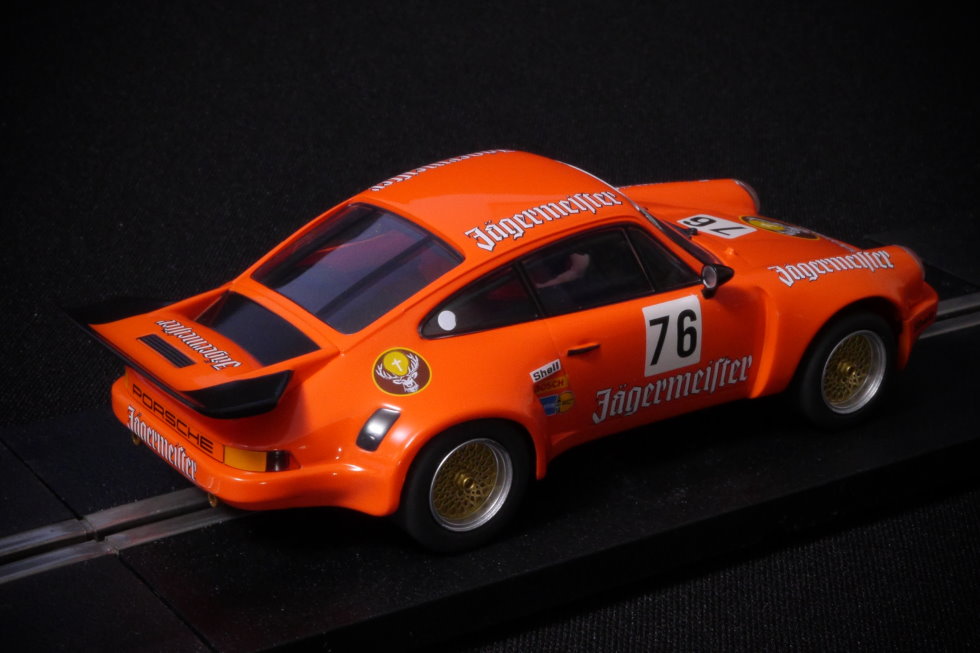
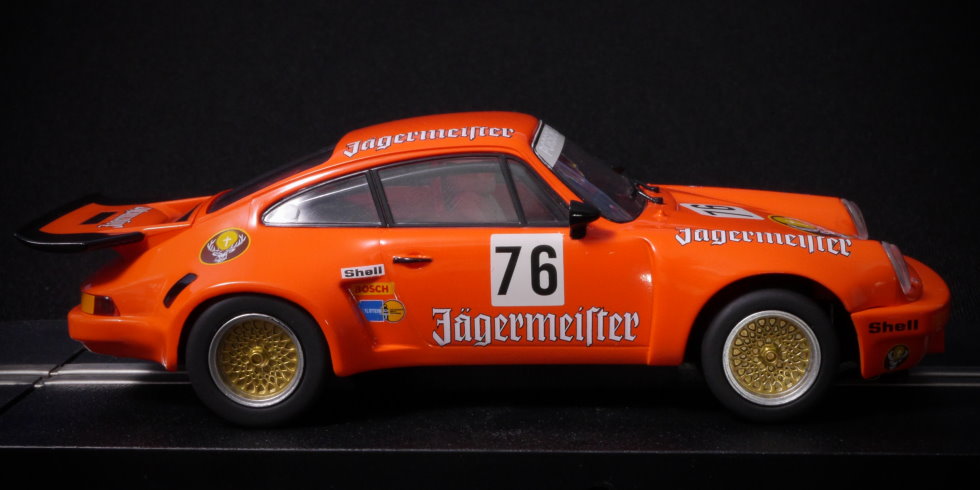
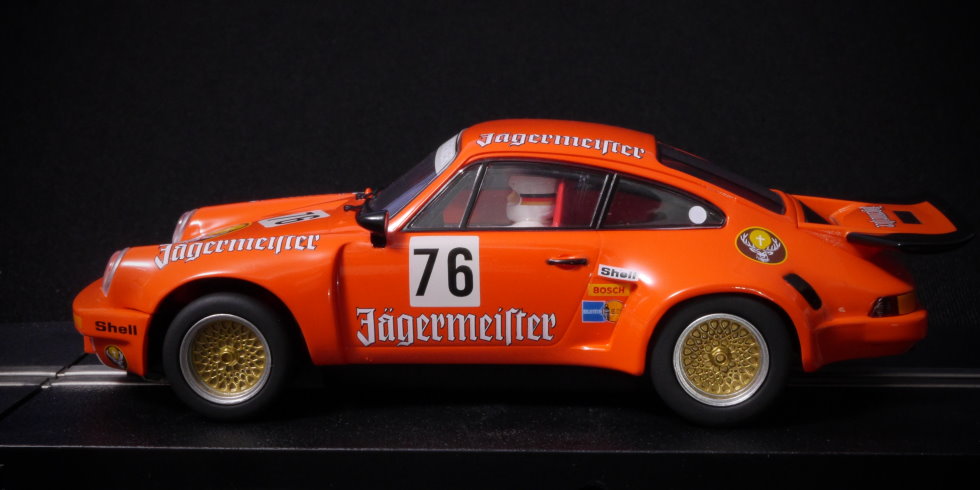
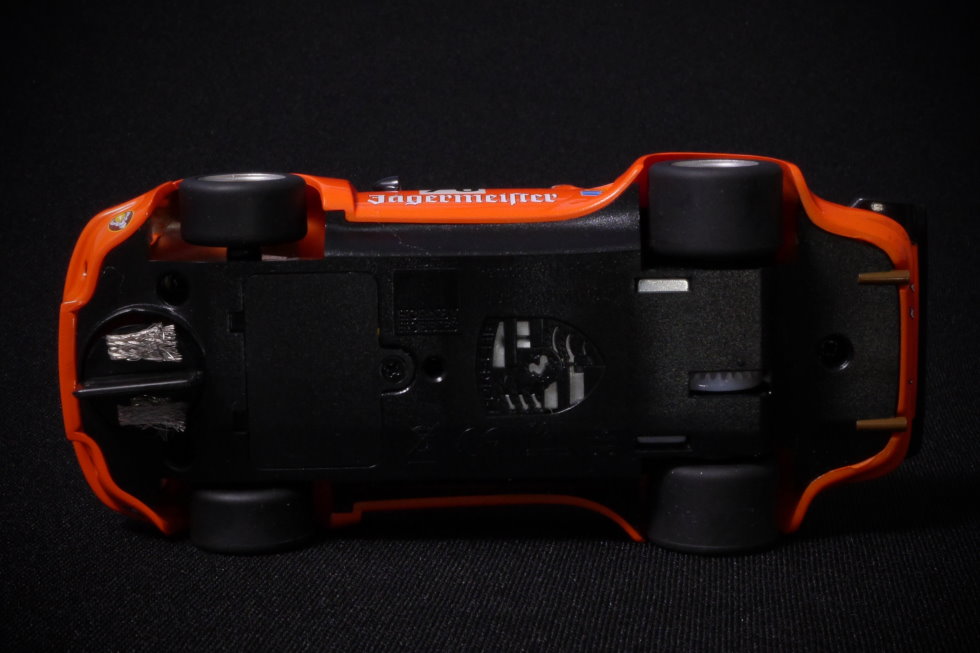
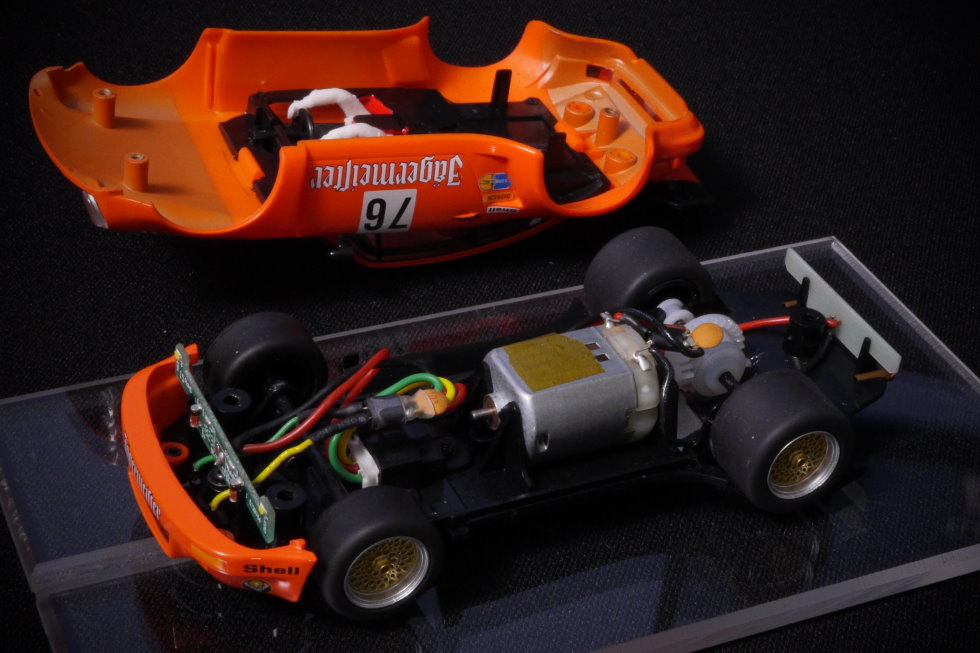
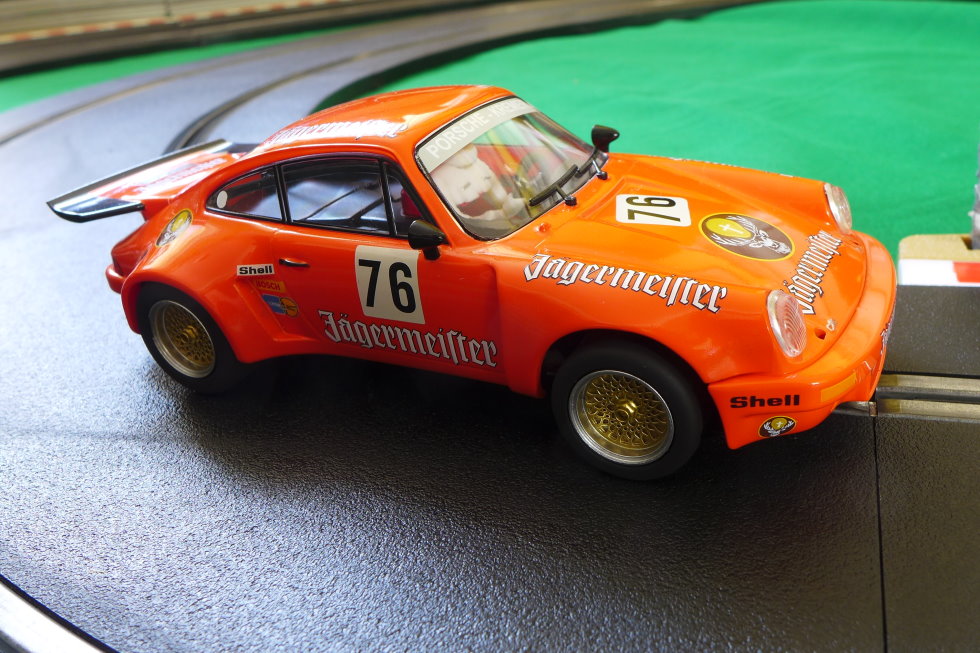
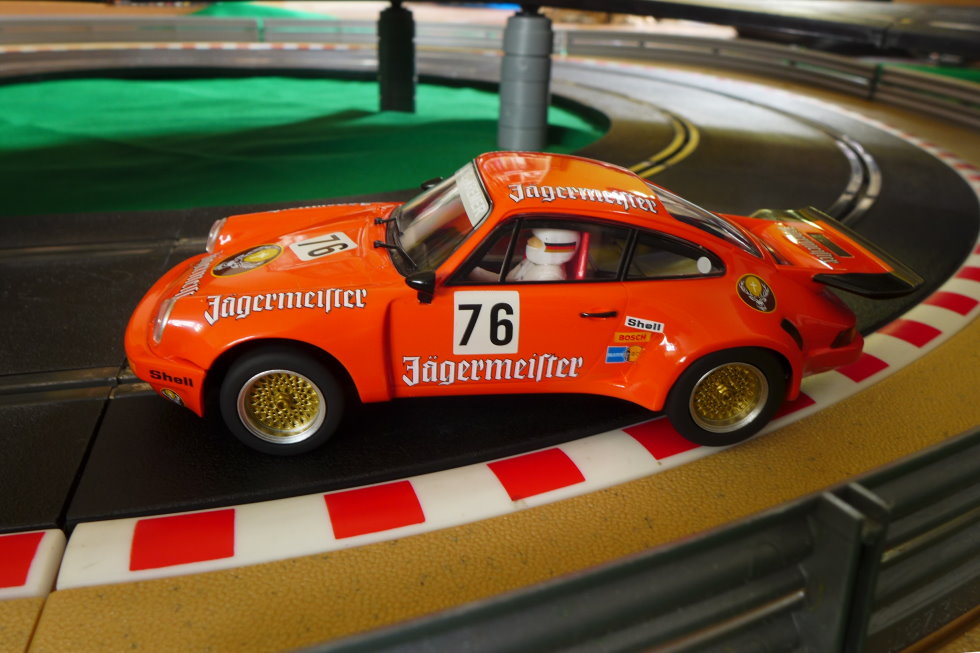
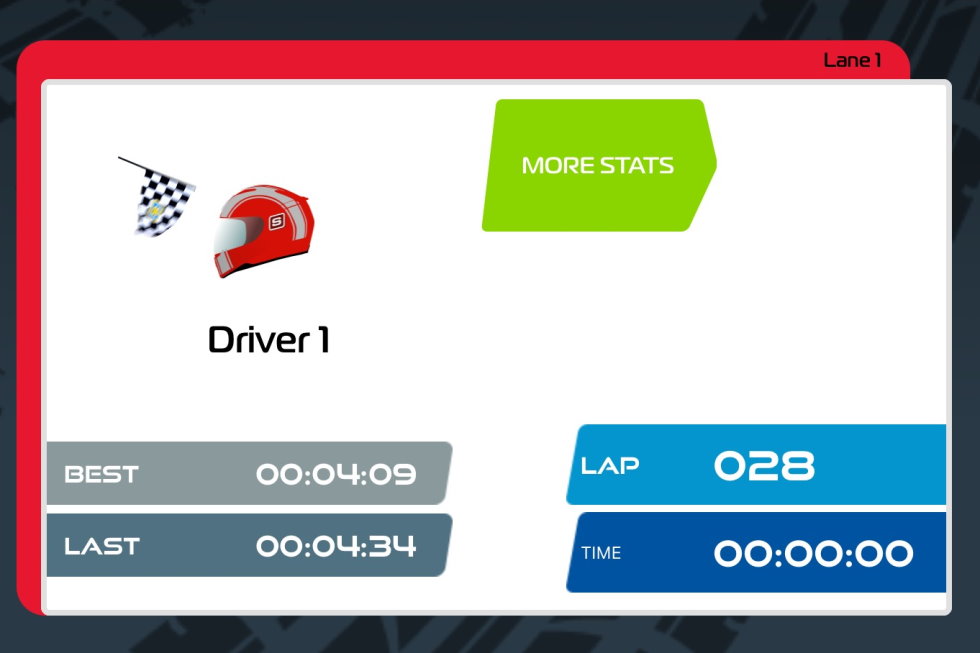
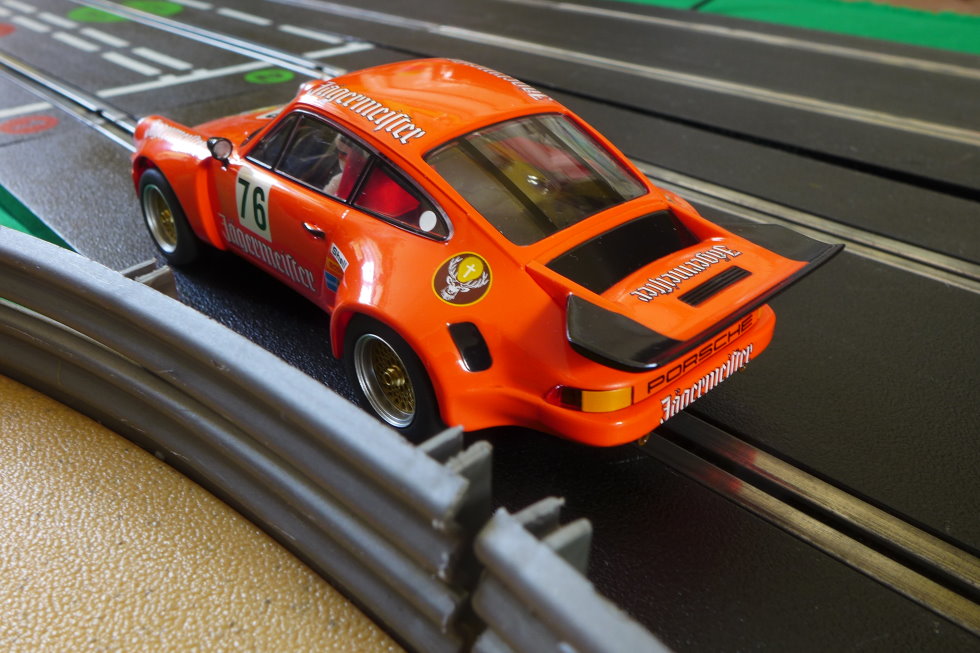
luverly looking car ,
Do you know if the scalextric PCR chassis will fit this car ?
Hi David. This is a very different model to the modern Porsche 911 RSR that had a PCR chassis produced for it. I think your best bet is to keep an eye on the 3D-printed chassis market – I’m pretty sure someone will have a chassis for this new model a few months after it is released.